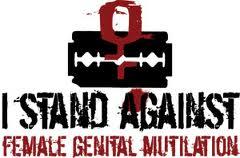
The Jakarta Post December 2012
Govt told to stop female circumcision
As the United Nations has adopted a resolution urging member states to ban female genital mutilation, the government has been told it has no choice but to revoke a Health Ministry regulation issued in 2010 that condones female circumcision.
National Commission on Violence against Women (Komnas Perempuan) deputy chairwoman Masruchah said that the 2010 ministerial regulation runs counter to the UN resolution because it legalizes a practice that is harmful to the sexual and reproductive health of women.
The UN General Assembly unanimously approved the resolution, which is not legally binding, on Thursday, urging its 193 member states to enforce legislation that prohibits female genital circumcision.
The 2010 Health Ministry regulation stipulates that female circumcision is allowed as long as it is performed by licensed doctors, nurses or midwives.
“We have consistently pushed the ministry to revoke that regulation because it abuses the reproductive rights of women. This practice stems from the erroneous interpretation of cultural and religious teachings,” Masruchah told The Jakarta Post.
Many Indonesians, she said, believed that female circumcision could control the sexual desires of girls.
Instead of providing health benefits, female genital mutilation can cause severe bleeding, urination problems and can lead to complications during childbirth, according to the World Health Organization (WHO).
The Health Ministry website claims that female circumcision, as stipulated in the regulation, cannot be categorized as female genital mutilation.
The regulation stipulates that “female circumcision is an action of incising the skin that covers the front part of clitoris, without harming the clitoris”.
The Indonesian Doctors Association chairman, Zaenal Abidin, said that the association would study the UN resolution and that they would issue a recommendation related to female circumcision.
“The association cannot make any recommendations unilaterally. We will involve religious scholars and communities in the deliberations. We will also study the suggestions from the WHO and international doctors’ associations,” he said.
...
Indonesian General Practitioners Association member Enrico Renaldi, who believes that female circumcision is unnecessary and harmful, said that medical practitioners in the country were facing challenges in preventing the practice.
“It is hard for doctors to be agents of change. There are strong pros and cons in the matter. Indonesians, particularly those in rural areas, see female circumcision as a necessity,” Enrico said.
Iffah Ainur Rochmah, the spokesperson for the Islamic group Hizbut Tahrir Indonesia (HTI), rebuffed the negative assumptions about female circumcision practices in Indonesia.
“This is a part of our culture rooted in Islamic teachings. The practice should be carried out through procedures that will not cause health implications,” she said.
Iffah called on the global community, including the UN, to not liken Islamic female circumcision with the unhygienic and inhumane practice of female genital mutilation.
She explained that Islam teachings regulated female circumcision as a minor incision of the skin that covers the front part of the clitoris.
...
Govt told to stop female circumcision
As the United Nations has adopted a resolution urging member states to ban female genital mutilation, the government has been told it has no choice but to revoke a Health Ministry regulation issued in 2010 that condones female circumcision.
National Commission on Violence against Women (Komnas Perempuan) deputy chairwoman Masruchah said that the 2010 ministerial regulation runs counter to the UN resolution because it legalizes a practice that is harmful to the sexual and reproductive health of women.
The UN General Assembly unanimously approved the resolution, which is not legally binding, on Thursday, urging its 193 member states to enforce legislation that prohibits female genital circumcision.
The 2010 Health Ministry regulation stipulates that female circumcision is allowed as long as it is performed by licensed doctors, nurses or midwives.
“We have consistently pushed the ministry to revoke that regulation because it abuses the reproductive rights of women. This practice stems from the erroneous interpretation of cultural and religious teachings,” Masruchah told The Jakarta Post.
Many Indonesians, she said, believed that female circumcision could control the sexual desires of girls.
Instead of providing health benefits, female genital mutilation can cause severe bleeding, urination problems and can lead to complications during childbirth, according to the World Health Organization (WHO).
The Health Ministry website claims that female circumcision, as stipulated in the regulation, cannot be categorized as female genital mutilation.
The regulation stipulates that “female circumcision is an action of incising the skin that covers the front part of clitoris, without harming the clitoris”.
The Indonesian Doctors Association chairman, Zaenal Abidin, said that the association would study the UN resolution and that they would issue a recommendation related to female circumcision.
“The association cannot make any recommendations unilaterally. We will involve religious scholars and communities in the deliberations. We will also study the suggestions from the WHO and international doctors’ associations,” he said.
...
Indonesian General Practitioners Association member Enrico Renaldi, who believes that female circumcision is unnecessary and harmful, said that medical practitioners in the country were facing challenges in preventing the practice.
“It is hard for doctors to be agents of change. There are strong pros and cons in the matter. Indonesians, particularly those in rural areas, see female circumcision as a necessity,” Enrico said.
Iffah Ainur Rochmah, the spokesperson for the Islamic group Hizbut Tahrir Indonesia (HTI), rebuffed the negative assumptions about female circumcision practices in Indonesia.
“This is a part of our culture rooted in Islamic teachings. The practice should be carried out through procedures that will not cause health implications,” she said.
Iffah called on the global community, including the UN, to not liken Islamic female circumcision with the unhygienic and inhumane practice of female genital mutilation.
She explained that Islam teachings regulated female circumcision as a minor incision of the skin that covers the front part of the clitoris.
...









